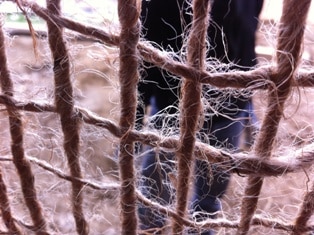
The host was very interested in using the netting as a means to lower his costs and use a natural material. I agreed with the idea after researching it a bit and learning that it had been used to supposed success on other projects.
Now you probably know by now that I am a huge fan of using welded wire mesh on my structures for many reasons, so opting for the jute netting in place of the mesh was a big step for me. It’s not like I went to therapy to get over making the decision, but it was, nonetheless, a stretch of my comfort zone!
The title of this entry mentions the word “why” so I will get to that now. I will not use use jute again in my structures, unless for some absolute necessity, because:
- There is absolutely no “real” strength in the material. When I pulled on sections of the jute to see if I could tighten it across the face of the bales, it ripped. I’m strong, but not that strong! If I pull on mesh all that happens is I hurt my hand.
- The material is woven. This, once again, means there is no strength in the material; this time for shear resistance. If you pull the material one way, the weave opens up. This is great for stuffing because you can literally open the jute up as wide as you want, right in the middle of the sheet; however, it makes for a weak material to hold the bales in place or provide shear strength.
- It’s bulky when not pulled super tight. If the material is not pulled really tightly apart, the ropes of the weave lie close to each other, creating a sheet of jute rather than a net of it. This sheet would keep any plaster attached to it separate from the bales. Not a good way to key the plaster into the straw for sure. As I mentioned in reason #1, you can’t pull the material that tight because it rips if you do.
- Sewing the jute to the walls only makes the loose areas stand out more. I had hoped that the stretchy material would tighten to the bales once sewn but this was not as I had hoped. It did tighten up directly under the sewing, but the sewn area did not lend any strength to immediate adjacent areas like welded mesh does.
I know some people will say that jute works and they will mention that they have used it themselves with success. Great! I am glad it worked for you. This is a material I am clear about for my own projects and those that I teach on. I will not use it again. Welded wire mesh is superior for several reasons and I am completely sure that the mesh is the best way to go.



2 Responses
I can see exactly what you mean with regard to this material, but what about coir mesh? I haven’t heard of anyone using coir mesh, but it seems to me that it could be excellent, as it is far stronger and stiffer than jute and should pull up nice and tight I would imagine. Cheers.
Hi Chris. I think you’ll find very similar results to the jute netting with coir mesh. My preference is still the welded wire mesh for the best results.